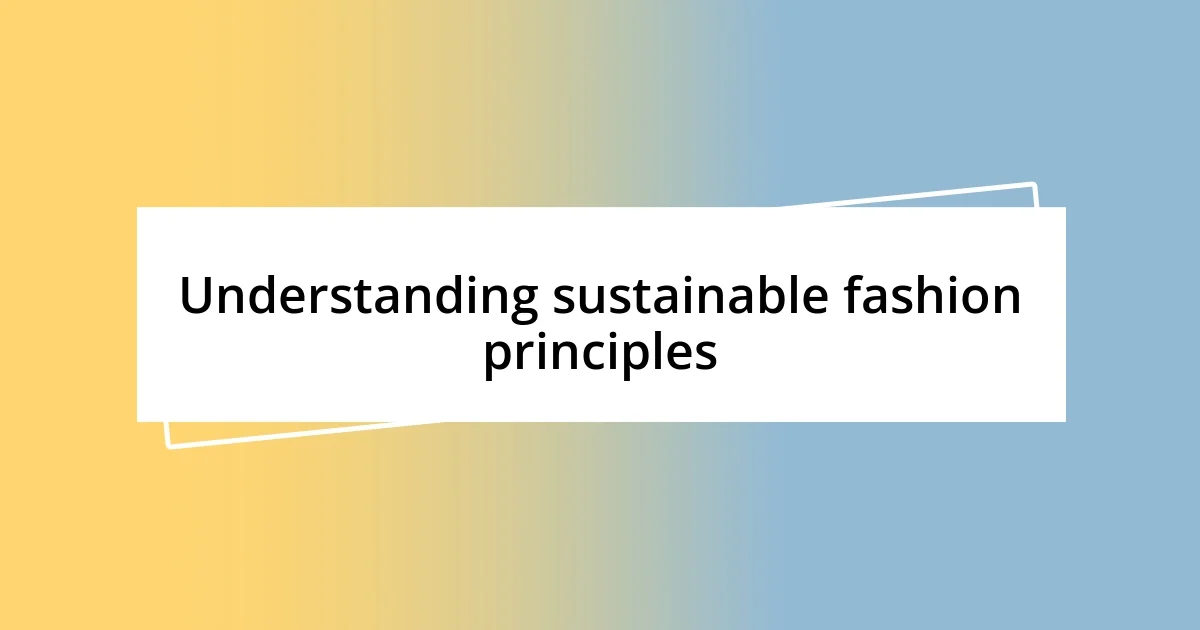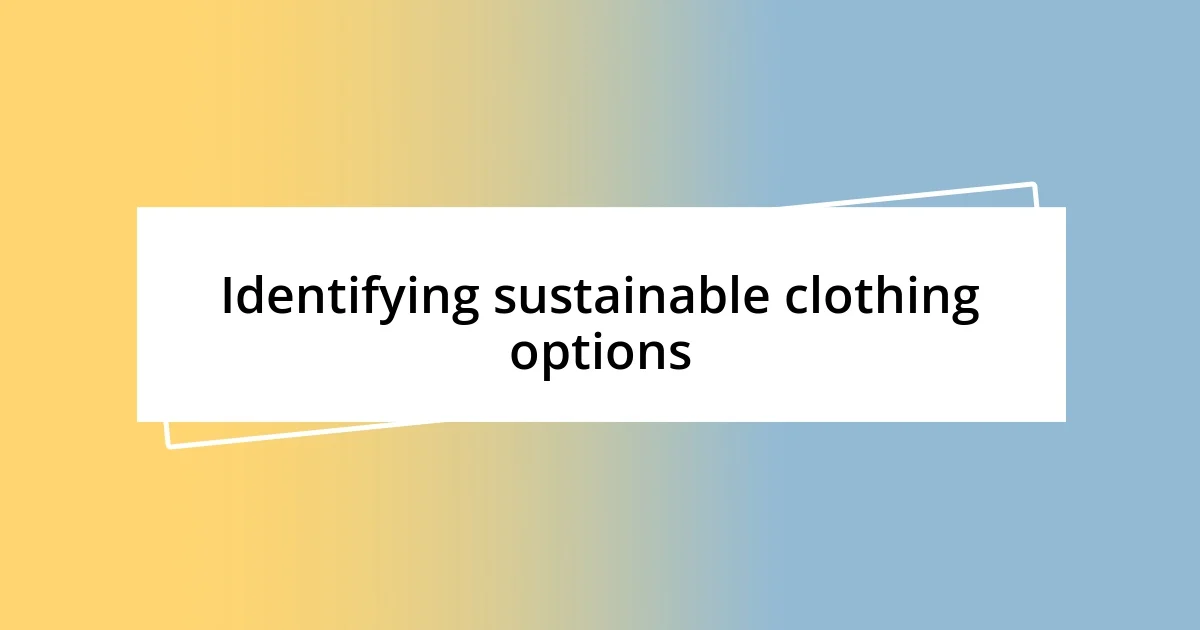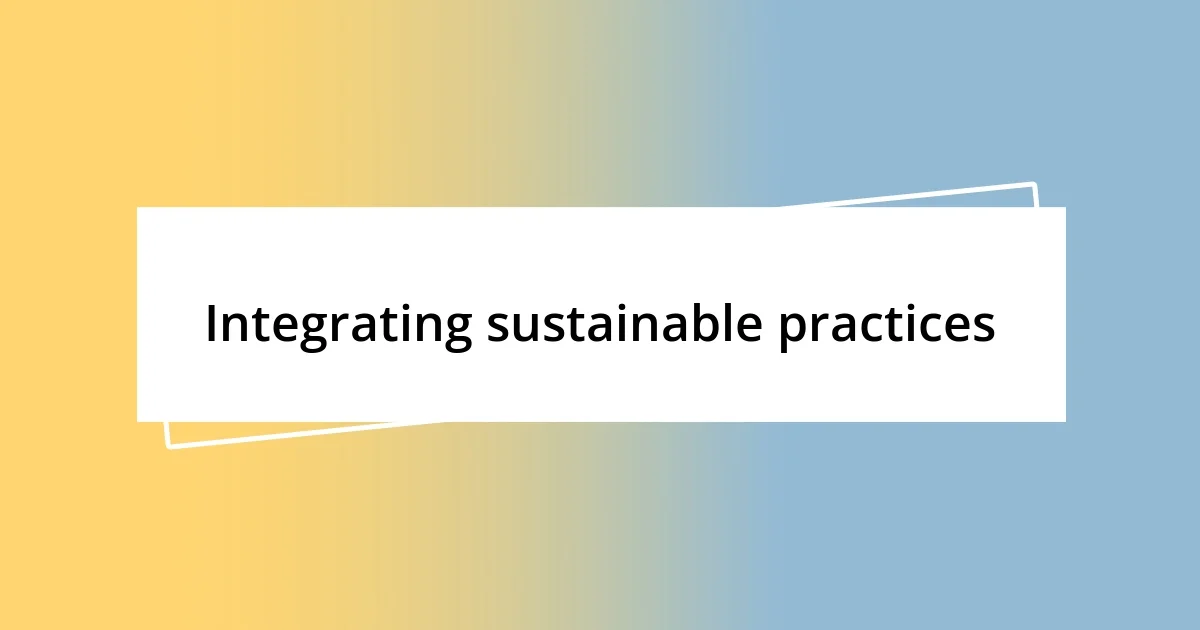Key takeaways:
- Transitioning to sustainable fashion emphasizes quality over quantity, ethical production, and a cyclical approach, encouraging reuse, recycling, and upcycling.
- Building a capsule wardrobe helps simplify choices and enhances personal connection to clothing, focusing on versatile and meaningful pieces.
- Integrating sustainable practices involves mindful purchasing, better garment care, and community sharing through clothing swaps, fostering deeper relationships and reducing waste.

Understanding sustainable fashion principles
When I first started exploring sustainable fashion, I was surprised to learn that quality trumps quantity. I used to think it was all about finding the perfect trendy pieces, but I soon realized that investing in durable garments not only reduces waste but also enhances my wardrobe’s longevity. Have you ever noticed how a well-made item feels better, both in terms of comfort and sustainability?
A cornerstone of sustainable fashion is the emphasis on ethical production. It was eye-opening for me to discover the impact of fast fashion on workers and the environment. I remember reading about the struggles of garment workers, and it made me reconsider my clothing purchases. How often do we stop to think about the hands that crafted our clothes and the conditions they work in?
Lastly, I’ve come to understand that sustainable fashion encourages a cyclical approach, focusing on reusing, recycling, and upcycling. I’ve actually started swapping clothes with friends, which not only refreshes my wardrobe but also creates a sense of community. Hasn’t it crossed your mind that fashion can be about relationships and stories, rather than just new items on a hanger?

Analyzing my current wardrobe
As I began analyzing my current wardrobe, I realized just how many items I owned that had barely seen the light of day. It was a bit shocking to confront the fact that many of these pieces lacked versatility or were impulse buys from years past. I found myself asking questions like, “When was the last time I wore this?” and “Does this garment truly reflect my personal style or values?”
To better understand what I had, I made a list of what my closet contained:
- Overall count of items: 35 pieces
- Favorites worn frequently: 10 items
- Sentimental pieces (kept but rarely worn): 5 items
- Trendy items that haven’t been worn in over a year: 8 items
- Basic staples in good condition: 12 items
This process made me appreciate the essentials I love and use regularly while also shining a light on the items that hadn’t brought me joy. I could feel the weight of those unused garments—clothes that once excited me now felt more like clutter. It reminded me that a sustainable wardrobe is more about intentional choices than sheer volume.

Identifying sustainable clothing options
Identifying sustainable clothing options can feel daunting at first. One of the most eye-opening moments for me was discovering brands that prioritizes eco-friendly materials, like organic cotton and recycled polyester. I vividly remember the excitement of finding a brand that uses fabrics made from plastic bottles. Imagine wearing a shirt that helps keep the ocean cleaner! It made getting dressed feel like an act of purpose.
Moreover, I learned to deeply value transparency in production methods. When browsing for clothes, I now actively seek out brands that disclose their supply chains and ethical labor practices. This shift transformed my shopping habits; I no longer look at a price tag in isolation but think about the people and processes behind the products. It’s truly enlightening — have you ever explored how your favorite brands operate?
Lastly, I embraced second-hand shopping as a sustainable choice, and it has become one of my favorite pastimes. Thrift stores and online resale platforms offer hidden gems that come with unique stories. I once stumbled upon a vintage jacket that instantly elevated my wardrobe, and knowing I saved it from a landfill tugged at my heartstrings. It’s incredible how many sustainable options are out there; they just require a shift in perspective and a bit of exploration.
| Option Type | Examples |
|---|---|
| Eco-Friendly Brands | Patagonia, Everlane, Reformation |
| Second-Hand Shopping | Thrift stores, Poshmark, Depop |
| Upcycled Clothing | Reclaimed wood clothing, artisan repurposed items |

Making conscious purchasing decisions
Making conscious purchasing decisions requires a shift in how I view my wardrobe. Initially, I used to focus solely on trends and discounts, but now I ask myself, “Do I really need this?” or “Will this piece add value to my collection?” For instance, I vividly recall purchasing a stunning dress on a whim during a sale. It hung in my closet, unwearable, a reminder of a fleeting moment rather than a thoughtful addition.
When I shop, I now prioritize quality over quantity. Each piece I consider must meet a certain standard: it should be durable, versatile, and ideally made from sustainable materials. I find myself gravitating towards items that not only resonate with my style but also come from brands that align with my values. One memorable experience was buying a beautifully crafted sweater made from sustainably sourced wool. It felt good not only to wear it but also to know it supported ethical practices.
I’ve also started collaborating with friends for a “swap party,” where we exchange clothes we no longer wear but that others might cherish. This approach gives items a new life while minimizing waste. Have you ever considered how sharing can create a more sustainable wardrobe? It’s become one of the most enjoyable parts of my shopping journey, proving that conscious decisions can truly transform my approach to fashion.

Building a capsule wardrobe
Building a capsule wardrobe is a game changer in my journey towards sustainability. The concept revolves around curating a limited selection of high-quality, versatile pieces that can be mixed and matched, ultimately simplifying decisions and reducing waste. I remember the feeling of freedom when I finally let go of redundant items that cluttered my closet, leaving only the essentials that I truly loved and wore frequently. Have you ever experienced that refreshing moment of clarity when your space feels more intentional?
I started this process by choosing a color palette that works harmoniously together. This made it easier to pick pieces that not only expressed my style but also coordinated well. For instance, my go-to neutral tones mixed with a few accent colors have transformed my daily wardrobe choices. I recall putting together an outfit for a casual brunch with friends and feeling confident knowing everything in my closet could work together effortlessly. It’s surprising how much simpler life becomes when you have a thoughtfully chosen collection.
The emotional aspect of building a capsule wardrobe is profound. Each piece I select has its own story, from the cozy sweater gifted by a dear friend to the timeless trousers I found at a local thrift store. This deeper connection I have with my clothes makes getting dressed feel meaningful. Have you thought about how the stories behind your clothing affect your connection to them? Embracing a capsule wardrobe has led me to cherish not just the clothes, but the memories they represent, changing my relationship with fashion for the better.

Integrating sustainable practices
Integrating sustainable practices into my wardrobe has truly reshaped how I view fashion. I’ve committed to researching brands before purchasing, ensuring they prioritize sustainable materials and ethical labor practices. Recently, I stumbled upon a brand that uses recycled fabrics, and it brought me immense joy to buy a pair of jeans knowing they contributed to a smaller environmental footprint. Have you felt that sense of satisfaction when you know you’re supporting something bigger than just style?
I also make a conscious effort to care for my clothes better. For instance, I’ve shifted to hand washing delicate items, which not only extends their lifespan but also reduces water usage. I remember the first time I repaired a small tear in my favorite shirt instead of tossing it. That moment was transformative; it felt like I was breathing new life into an item I loved rather than letting it fade away. Have you ever thought about how small changes can have a significant impact on your fashion choices?
Moreover, I’ve embraced second-hand shopping as a routine part of my sustainable journey. Thrifting has opened my eyes to unique finds, like that vintage leather jacket that instantly became a wardrobe staple. It’s an exhilarating treasure hunt; each trip is filled with possibilities, and I often think about the stories behind each piece. Do you find yourself drawn to the idea of giving quality items a second chance? Integrating these sustainable practices has not only enhanced my wardrobe but enriched my life in ways I hadn’t expected.

Maintaining a sustainable wardrobe
Maintaining a sustainable wardrobe requires ongoing commitment and mindfulness. I make it a habit to periodically evaluate my closet, asking myself if I still love and wear each piece. It’s like a little ritual for me. The last time I did this, I found a beautiful blouse I hadn’t worn in ages, and I had to decide: do I love it enough to keep it? Ultimately, I let it go, and the process felt liberating. Have you ever reassessed your closet and been surprised by what you discover?
Caring for my garments has become a practice of creativity and intention. I’ve started experimenting with upcycling, which has reignited my passion for DIY projects. For example, I once transformed an old denim jacket into a trendy bag simply by adding a few embellishments. That bag isn’t just functional; it carries special memories from the transformation process. Have you considered how a little creativity can change your perspective on clothing?
Sharing and swapping clothes with friends has also played a vital role in maintaining my wardrobe. Instead of buying something new for an event, I invite friends over for a closet swap. It’s like shopping without spending a dime! I remember the excitement of discovering pieces from a friend’s wardrobe that I absolutely loved, and she felt the same about mine. Do you think your friends might enjoy the thrill of finding unique items in each other’s closets? This sense of community not only helps reduce consumption but fosters deeper connections with the people I care about.














